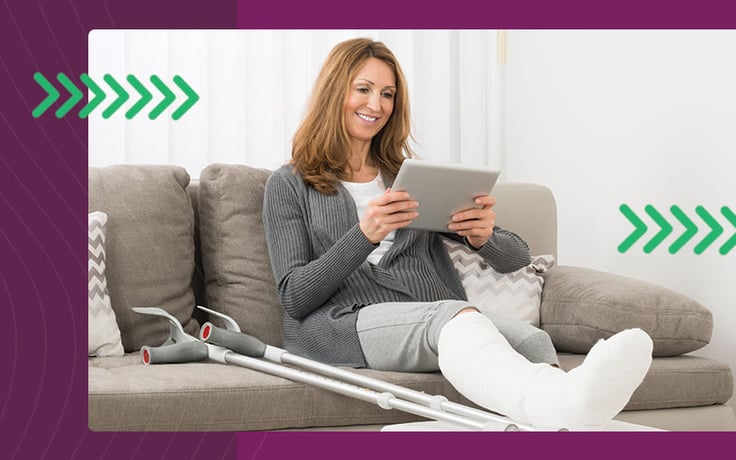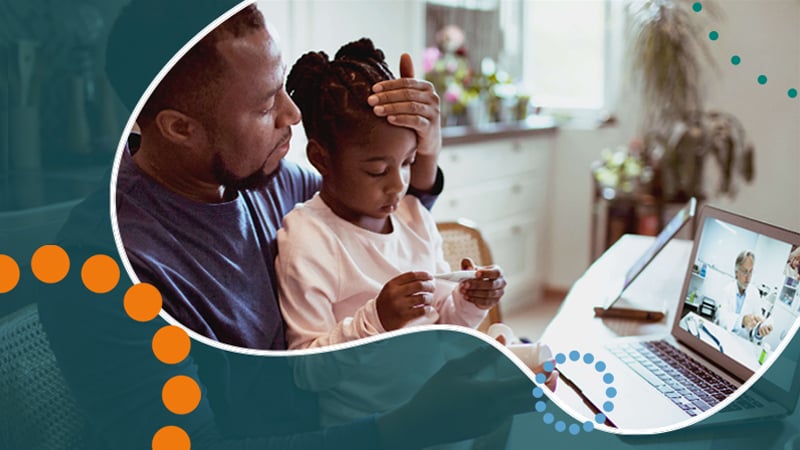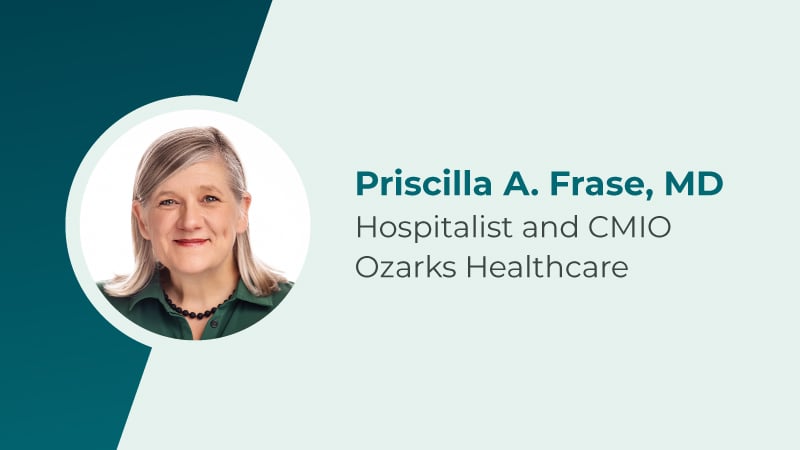
Many of the healthcare issues that surfaced during the pandemic have also been left behind in its wake. Everything from clinician burnout and cognitive burden, to a shortage of healthcare workers and hospital backlogs. Whether brought on by the pandemic or exacerbated by it, we simply can’t sit back and hope these problems will resolve themselves.
In 2021, during our attempt to uncover innovative ways to deal with the pandemic, we capitalized on an opportunity that would eventually grow to become much more successful than what we had expected.
During the COVID-19 lockdown, we needed to limit the number of people coming to the hospital and virtual care increased as a way to deliver care and stay connected with patients. While we’re now welcoming patients back, the need and desire for virtual solutions remain, especially as hospitals face backlogs of patients returning for surgeries and other procedures that were delayed during the pandemic. We’ve since evolved our interventions and rationale and extended our support for patients through remote care monitoring (RCM) capabilities.
Rising patient volumes necessitate that we find a balance between those patients who need to be in the hospital and those patients who can transition home, especially since we know there are certain advantages to recovering at home. RCM solutions provide us with a safe way to achieve this, especially post-surgery. This is one way that hospitals are able to manage the demand for valuable resources.
Starting with a solid strategy
The transition from hospital to home is a critical phase in a patient’s journey, as it significantly impacts recovery and the health system’s efficiency. That’s why it was important for us to launch a surgical transitions remote care monitoring program to help create smoother and safer transitions from hospital to home.
As we were building our strategy for the RCM program, we considered the areas where it would have the most immediate impact, acting as the catalyst to set us on the right course. We decided to first focus on hip and knee replacements, as they are some of the most common surgeries for patients. And while the need continues to grow as the population ages, we’re starting to see that patients undergoing these joint replacements are trending younger.
For the program to be successful, it was imperative that we identified the right technology to engage patients throughout their recovery, but also one that didn’t add unnecessary burden to physicians and other care providers. This meant adopting a solution that would integrate directly into our MEDITECH Expanse EHR and virtually guide and remotely monitor patients throughout their episodes of care. We chose SeamlessMD, a leading digital care platform.
Creating ways to add value to clinicians is key, and the integration of SeamlessMD with our Expanse EHR does just that. But there’s more to it than what meets the eye. Providing more information to clinicians isn’t enough. The information isn’t going to be accessed unless it’s easy. If it takes more than one or two clicks or is a hassle in any way, clinicians will just say, ‘forget it’ and move on with their day. The integration overcomes that potential hurdle, as clinicians can access valuable patient information immediately — without leaving the EHR.
The results speak for themselves. An initial evaluation of our surgical program comparing RCM patients to non-enrolled patients showed the following improvements:
- 72% decrease in 30-day ED Visits
- 64% decrease in 30-day Readmissions
- 8% decrease in Length of Stay
We’ve since deployed the RCM program across an additional 13 care pathways, including
general surgery, cancer, women’s health, chronic care, and mental health. Most recently, we’ve expanded it to our Medicine Program with a focus on Chronic Obstructive Pulmonary Disease and Congestive Heart Failure, and we’re creating a new Maternity pathway to better support expectant mothers and their families throughout the many transitions of maternal care.
This innovation has also allowed us to increase the number of same-day-surgeries; which is now the case for the majority of patients undergoing joint replacements. Furthermore, the RCM program has augmented homecare or even replaced homecare service if it is not available. In other words, RCM can fill gaps in the system of care if/where any exist, for example, by providing support for wound management and guidance for physiotherapy exercises that patients can do at home.
Garnering valuable insights
As part of the RCM program, providers send patients instructions and reminders, receive alerts, and measure analytics through dashboards launched from Expanse. On the patient side, they self-manage their conditions and complete health checks using a smartphone or other device. They receive clinical guidance and education throughout their recovery, including when to escalate concerns to their providers.
Care teams monitor patient symptoms along with recovery progress, identifying changes in health status and intervening when needed. And because they can easily view detailed patient information without exiting the EHR, we’ve been able to improve our clinical care delivery without adding burden to our clinicians.
The value added to our work is that the solution provides real-time data for clinical use. This is the difference between apps and programs that aren’t monitored and/or interventions that do not include real-time patient-reported outcome measures (PROMS), which are standardized, validated surveys used to study how patients feel about their health status.
As Dr. Graham Elder, our Chief of Orthopaedics noted, gathering data in real time also allows us to gain deeper insight into the patient’s day-to-day behavior. These previously unknown details — which we can use to inform diagnosis and treatment — may prove even more beneficial when clinicians are assessing a patient they’re not familiar with.
Creating a new level of patient engagement
To date, we have had over 2,000 patients enrolled in the program and feedback has been overwhelmingly positive. In particular, patients note that the program has helped improve their confidence and allay their anxiety:
- 94% felt that the program helped them feel more confident before surgery.
- 91% felt it helped them feel more confident at home after surgery.
- 37% reported that enrollment prevented one or more calls to the hospital.
Here are just a couple of examples of what we hear from RCM patients on a regular basis:
“Absolutely this is a wonderful program. Very helpful. It makes you feel better knowing that you're being tracked each day. If you have any questions about your care, help is a click away.”
“I would like to thank everyone that was involved in my care prior to surgery, during surgery and the Surgical Transitions program. This program has helped me cope with stress and feeling anxious. It reminded me of the importance of doing the exercises, and going for my daily walks. I hope this program will be staying around for a long time.”
Testimonials such as these inspire us to keep developing innovative and sustainable programs that improve healthcare for everyone. Our success is just one example of how RCM can enable safer hospital-to-home transitions and simultaneously empower patients to actively participate in their care journey. On a broader level, such programs can efficiently expand access to care, as well as serve the rural patient population more effectively, especially as we continue to grapple with the healthcare worker shortage.
This is just as important now as it was during the pandemic so that we can prevent delays in treatment, which can often lead to needing a higher level of care. Given the right technologies, along with better educational materials and information, patients want to be engaged.
Solutions are here now and they work post-pandemic. This is what patients are expecting – they want to use technology in ways that help them manage their health, just like they use it elsewhere in their everyday lives.
Building a better healthcare system
We need strong leaders and bold risk-takers to do everything possible to shape an innovative, successful, and sustainable future, both in the short and the long term. Unfortunately, there is no panacea. At the macro level, there are those who lead discussions about system change, such as improving team-based care and emphasizing primary care as well as preventative medicine/health promotion. Others grapple with things like complex payment schemes and system measurement requirements that can bog us down.
While the most senior leaders wrestle with the many big challenges out there, we must also work at the macro and micro levels to bring about change closer to home, which is what we’re doing at Sault Area Hospital.
Complex problems require breadth and depth in our responses. But it’s not sufficient to simply plant seeds and hope for a thousand flowers to bloom. To the extent that it’s possible, we need to be deliberate in our actions and intentional in our perseverance.
Enter digital health innovation, which is at the heart of contemporary health systems transformation. And when we reach the next level of advancement, we must continue to think ahead and create new frontiers for the healthcare landscape. The call to action is infinite — let’s continue our bold efforts to improve patient outcomes and experience — as this noble cause is for the betterment of our communities now, and into the future.
See for yourself how healthcare organizations are using Expanse, so they can deliver the best care humanly possible.




